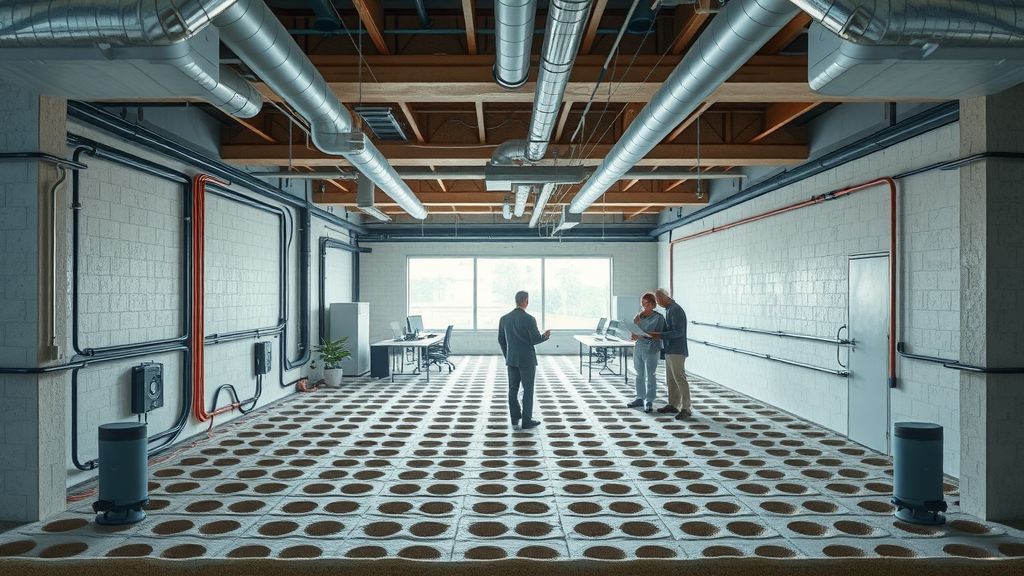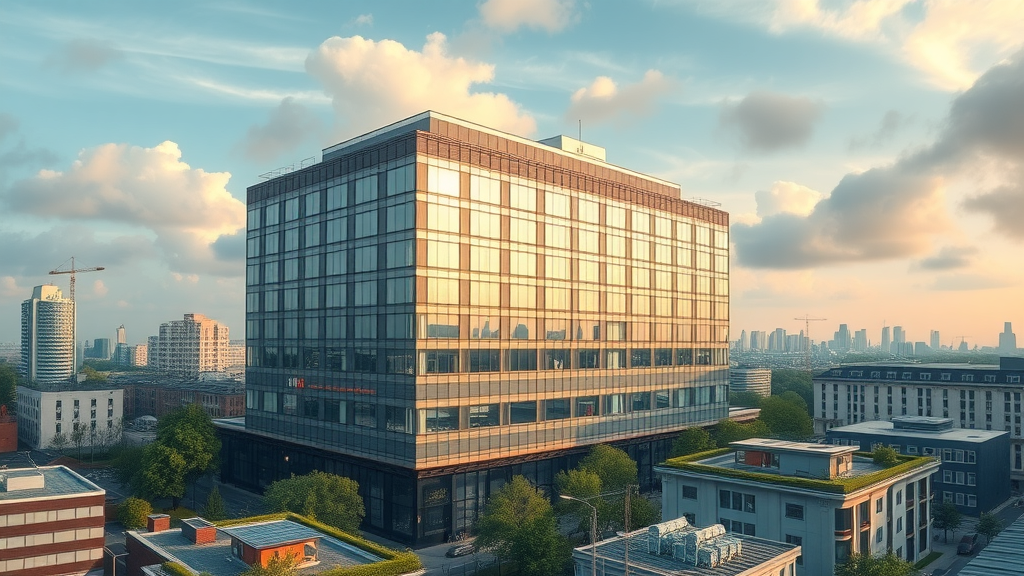Did you know that a staggering 85% of new commercial builds in the UK now consider floor heating solutions for energy efficiency and comfort? As modern businesses demand more from their spaces, commercial underfloor heating is quickly becoming the gold standard. Not only does it promise unmatched comfort and stylish minimalism, but it also offers significant cost savings while supporting sustainability. If you’re ready to future-proof your next project, this guide reveals everything you need to know about the smart, transformative potential of underfloor heating in your commercial property.
A Revolutionary Shift: Why Commercial Underfloor Heating is Transforming the Market
"85% of new commercial builds in the UK now consider floor heating solutions for energy efficiency and comfort." – Building Energy Council
Across the UK, commercial underfloor heating is rapidly gaining traction. Commercial property owners and developers are increasingly opting for this modern heating solution over traditional radiators and bulky HVAC systems. The shift isn’t just a matter of trendiness; it’s driven by tangible benefits including better energy efficiency, reduced operational costs, and a more inviting building atmosphere. The ability to maintain steady, even warmth throughout expansive spaces—without unsightly radiators or obstructed walls—makes underfloor heating a favourite in offices, retail, hospitality, and public institutions alike. This innovative technology brings both form and function, directly responding to the growing demands for adaptable, sustainable design. The influence of underfloor heating is so profound that it’s rapidly transforming expectations for comfort and energy use in commercial environments, making now the perfect moment to assess its potential for your next project.

What You'll Learn About Commercial Underfloor Heating
- The key benefits and features of commercial underfloor heating
- Comparison with traditional heating systems
- Guidance on choosing, installing, and maintaining underfloor heating
- Cost savings, energy efficiency, and sustainability insights
- Case studies and professional recommendations
What is Commercial Underfloor Heating?
How Floor Heating Works in Modern Commercial Buildings
At its core, commercial underfloor heating operates by turning your entire floor space into a gentle radiator. Instead of relying on clunky visible units, floor heating systems use pipes (for wet systems) or cables (for electric systems) embedded beneath the surface. These pipes or cables distribute radiant heat evenly across the room, eliminating cold spots and ensuring sustained comfort even on the coldest days. In large commercial buildings, advanced heating system controls can zonally manage temperature, offering custom settings for different zones—think open-plan offices, conference rooms, or even busy reception areas. The result? Consistently warm, operationally efficient, and aesthetically pleasing spaces for employees, clients, and visitors alike.
These systems are designed with modern structures in mind, integrating seamlessly with a wide range of floor coverings—from carpet tiles and laminate to luxury vinyl and porcelain. This flexibility allows underfloor heating to blend into the background while maximising usable space and minimising trip hazards or maintenance disruptions. Modern underfloor heating also pairs perfectly with energy sources like heat pumps, multiplying energy-efficiency savings well above what’s possible with traditional radiator systems or forced-air HVAC.
Types of Commercial Underfloor Heating: Wet vs. Electric Underfloor Heating
There are two main types of underfloor heating systems found in commercial properties: wet (hydronic) and electric underfloor heating. Wet systems circulate warm water through robust, insulated tubing laid across (or within) the subfloor; they're often paired with high-efficiency boilers or heat pumps and are suited to larger installations thanks to their low running costs and adaptability. Electric underfloor heating, meanwhile, uses thin wires or heating mats—ideal for retrofits, small spaces, or areas where rapid installation and minimal build height are required. Both can deliver comfortable, even warmth, but the right choice depends on project scope, usage requirements, and integration needs.
While electric underfloor heating systems are prized for their quick response times and easy integration with smart controls, hydronic (wet) systems offer exceptional ongoing energy efficiency, especially for larger floor areas. Some projects even pair both, using electric mats for rapid heat-up zones and wet systems for steady background warmth, harnessing the strengths of each for a truly bespoke solution.

Key Benefits of Commercial Underfloor Heating for Your Property
- Enhanced energy efficiency and reduced running costs
- Uniform temperature distribution
- Improved building aesthetics and space utilization
- Low maintenance and long life
- Healthier indoor air quality
Energy Efficiency and Sustainability with Underfloor Heating Systems
Energy savings are at the heart of modern building design—and commercial underfloor heating delivers in spades. Traditional systems often generate cold spots and inefficient heat loss, especially in large open-plan areas, due to uneven coverage and unavoidable air circulation patterns. Underfloor heating, by contrast, produces radiant heat consistently from the ground up, maximising the benefits of lower-temperature heat sources, like modern heat pumps and even solar integration. This means you can meet—and exceed—rigorous energy efficiency targets for both new builds and retrofit projects.
With the ability to operate effectively at lower water or electrical input temperatures, underfloor systems are the perfect partner for renewable source heat pumps and advanced climate control. Not only does this reduce monthly energy bills, but it also leads to impressively low carbon emissions. In fact, buildings adopting underfloor heating are frequently eligible for green building certifications and can demonstrate a clear commitment to sustainability—an increasingly important factor for tenants, investors, and end-users.
Comfort, Control, and Safety: Why Floor Heating Leads the Market
Comfort is more than just warmth—it’s stability, flexibility, and peace of mind. Commercial underfloor heating offers precise room-by-room or zone-by-zone temperature control, which is crucial in dynamic environments like hotels, office blocks, or healthcare centres. Say goodbye to overheating, drafts, or the fluctuating warmth of overworked radiators. Instead, enjoy even comfort throughout every inch of floor space.
Furthermore, by eliminating bulky radiators and exposed pipes, beautifully unencumbered interiors are possible. This means greater freedom in interior layouts, increased usable floor space, and fewer health and safety risks. The absence of moving air currents also drastically improves indoor air quality—especially beneficial for allergy-prone staff or sensitive electronics. Low maintenance requirements and built-in safety features make underfloor heating a clear leader for both building managers and facility teams seeking reliability and long-term value.
How Commercial Underfloor Heating Outperforms Traditional Heating Systems
When compared to traditional radiator and forced-air HVAC systems, commercial underfloor heating stands apart on multiple fronts. It delivers a significantly more efficient and comfortable user experience by providing radiant warmth from the ground up, ensuring no cold spots and unlocking more flexible design possibilities for architects and managers. Here’s how modern underfloor heating compares on key operational points:
| Feature | Commercial Underfloor Heating | Radiator System | HVAC System |
|---|---|---|---|
| Installation Cost | Medium (higher for wet) | Low-Medium | Medium-High |
| Energy Efficiency | Excellent (partners well with heat pumps) | Good (loses heat via air/walls) | Fair (energy lost via ducts) |
| Longevity | 30+ years | 10–15 years | 15–20 years |
| Design Flexibility | Maximum—hidden infrastructure | Bulky, restricts layout | Ducts impact ceilings/walls |
| Heating & Cooling | Heating (with options for cooling) | Heating only | Heating & Cooling |
Electric Underfloor Heating vs. Wet Underfloor Heating Systems
Electric underfloor heating systems and wet systems each offer specific advantages. Electric underfloor is perfect for small areas or retrofits, thanks to slim heating mats or cables that require minimal build height and offer rapid warm-up times. They're especially popular where installation speed or phased refurbishments are priorities. However, for larger spaces or new builds, wet underfloor heating systems (using warm water via pipes) are typically more economical to run and easier to integrate with heat pumps—maximising both immediate and long-term energy savings.
When choosing between the two, consider not just upfront costs but also building usage patterns, available floor build-up, and your long-term energy efficiency ambitions. In many commercial properties, a hybrid approach is used—deploying electric underfloor for targeted zones like boardrooms or entrances, and wet heating for open-plan areas or primary circulation spaces.
Choosing the Right Commercial Underfloor Heating Solution for Your Building
Key Considerations: Building Size, Usage, and Insulation
Selecting the most effective underfloor heating system requires careful consideration of factors unique to your commercial building. Begin with the size and function of the space—open warehouses, multi-storey offices, and specialist facilities all have different requirements. Assess the composition of existing floors, as certain floor construction types (such as concrete slabs vs. raised access floors) may favour one underfloor option over another.
- Floor construction types
- Heating system load calculations
- Integration with heat pumps and renewable sources
Next, conduct thorough heating system load calculations to ensure the selected system meets your warmth and comfort expectations throughout the year. Assess your building's insulation, as high-performance insulation will enhance the system's efficiency and maintain heat longer. Finally, consider future-proofing by ensuring compatibility with heat pumps or other renewable energy sources—these partnerships are crucial for long-term energy and cost savings.
Integrating Underfloor Heating with Other Heating and Cooling Systems
Modern commercial underfloor heating systems aren’t stand-alone—they’re designed for seamless integration with existing or planned heating and cooling infrastructures. This flexibility allows underfloor systems to serve as primary heating in temperate seasons while supplementing or partnering with HVAC for peak heat or cooling demands. In retrofit scenarios, underfloor heating can be phased in alongside old systems, minimising disruption and ensuring comfort is never compromised.
This integrated approach is especially effective in mixed-use developments, commercial offices, and retail centres, where different spaces may have varying requirements throughout the day. By combining underfloor with source heat pumps, cooling coils, or even solar-assisted heating, building managers can unlock year-round performance, lower running costs, and drastically reduce environmental impact.

A Step-by-Step Guide to the Installation of Commercial Underfloor Heating
- Initial site assessment
- Heating system design and specification
- Installation by supply and install specialists
- Testing and commissioning
- Ongoing maintenance and support
Why Professional Supply and Install Services Are Crucial
The success of your commercial underfloor heating project hinges on expert supply and installation. Only trusted specialists can balance correct system design with precise onsite execution. A skilled team carries out meticulous site assessments, translates unique project needs into custom system layouts, and ensures integration with other services and controls. This professional approach guarantees consistent warmth, safety, efficiency, and full compliance with all building regulations.

Working with Peak Underfloor Heating Ltd: Delivering Excellence
Our Expertise in Commercial Underfloor Heating Systems
With extensive experience in diverse commercial projects, Peak Underfloor Heating Ltd stands out for precision, adaptability, and client focus. We handle the full journey—from initial consultation and heating calculations to custom design, supply, installation, and aftercare. Our knowledge spans the integration of floor heating with advanced energy systems (like heat pumps), ensuring each solution is future-ready and perfectly fitted to your building’s needs.
"Our reputation for precision and adaptability in l building projects sets us apart in the heating solution market." – Peak Underfloor Heating Ltd
End-to-End Supply and Install: The Peak Approach
At Peak, we offer a true supply and install service, minimising handoffs and keeping communication streamlined. Our in-house experts work directly with architects, contractors, and M&E consultants, tailoring each system to the project’s precise demands. This single-point responsibility ensures full accountability and high-quality outcomes—from design to user training, ongoing maintenance, and system upgrades.
Cost Analysis: Is Commercial Underfloor Heating Worth the Investment?
One of the biggest factors affecting your decision will be cost. While commercial underfloor heating may require more up-front investment than some traditional systems, its operational savings, lifespan, and sustainability benefits offer exceptional value in the medium and long term. The table below compares typical cost elements for underfloor heating across several commercial building types.
| Building Type | Installation Cost (£/m²) | Annual Operating Cost (£/m²) | Projected Energy Savings (%) |
|---|---|---|---|
| Office (new build) | £40–£70 | £3–£6 | 30–40% |
| Retail Unit | £45–£75 | £3–£7 | 28–38% |
| Educational Facility | £38–£65 | £2.50–£5 | 32–45% |
| Healthcare | £50–£80 | £4–£8 | 25–38% |
ROI and Payback Periods for Commercial Properties
The return on investment (ROI) for commercial underfloor heating projects is highly attractive. While installation costs may be higher than for basic radiator systems, energy efficiencies, lower maintenance, and extended system lifespans mean that underfloor heating typically pays for itself within 5–8 years for most commercial buildings. Energy bill reductions and tenant satisfaction further contribute to improved asset value and operational predictability—crucial considerations for commercial asset managers and property owners.
Funding Options & Incentives for Underfloor Heating Projects
Multiple funding routes and financial incentives are available to support your investment in commercial underfloor heating. These include government grants for energy efficiency upgrades, low-cost financing options, local authority schemes, and enhanced capital allowances for green technologies. Additionally, pairing underfloor heating with heat pumps or renewable systems can unlock further subsidies or carbon offset rewards—helping you achieve sustainability goals and improve your bottom line.

Sustainability & Energy Efficiency Benefits of Commercial Underfloor Heating
Partnering with Heat Pumps for Maximum Energy Efficiency
The biggest sustainability breakthroughs in heating come from combining underfloor systems with modern heat pumps. Unlike fossil-fuel boilers, heat pumps use renewable energy to deliver up to four times more heat energy than the electricity they consume—dramatically slashing carbon emissions. When coupled with low-temperature underfloor heating, this synergy unlocks exceptional energy efficiency, helping your building earn green building accreditations while keeping operational costs in check.
Improved Environmental Outcomes and Green Building Accreditations
Installing commercial underfloor heating supports a preventive approach to climate impact, enabling architects and developers to meet and exceed sustainability targets. Certifications such as BREEAM and LEED become more attainable as energy performance and tenant well-being improve. Lower carbon footprints, reduced waste, and healthier, more productive interiors collectively future-proof your investment—aligning commercial priorities with social and environmental responsibility.
Maintenance and Longevity: Caring for Your Commercial Underfloor Heating System
Routine Maintenance Requirements
One of the key advantages of underfloor heating systems is their simplicity and minimal maintenance needs. Regular checks are usually straightforward: periodic functional tests, occasional valve and manifold inspections, and routine cleaning of filter components in wet systems. Unlike radiator systems, there are no exposed elements at risk of accidental impact or dust accumulation. Partnering with a professional service provider ensures your system is always performing at its best—maximising efficiency and avoiding unexpected downtime.
Expected Lifespan and Troubleshooting Common Issues
With correct installation and regular professional servicing, most commercial underfloor heating systems are designed for service lives exceeding 30 years. Common issues, such as uneven heating or unusual noise, are typically resolved through simple controls adjustments or air bleeding from wet circuits. Most manufacturers and trusted installers, such as Peak, offer detailed aftercare guidance and responsive support should any troubleshooting be required.
Real-World Success: Case Studies in Commercial Underfloor Heating
Educational Facilities: Enhancing Comfort and Reducing Costs
A recent project in a large secondary school saw the installation of hydronic underfloor heating throughout classrooms, corridors, and sports halls. The school prioritised both energy cost reductions and student comfort. The system’s steady radiant warmth eliminated temperature fluctuations and reduced joint pain among staff and students. In just one year, the school reported slashed energy costs and a more consistent, healthier indoor environment.
Retail and Office Projects: Bespoke Underfloor Heating Solutions
A busy city-centre office replaced their ageing HVAC and old radiators with a hybrid underfloor heating setup managed by smart zoning controls. Immediate benefits included more usable floor space, greater design flexibility, and substantially improved air quality—a critical advantage for employees with allergies. The landlord’s feedback? “Switching to an underfloor heating system reduced our energy bills by 30%.”
"Switching to an underfloor heating system reduced our energy bills by 30%." – Commercial Property Manager

People Also Ask: Commercial Underfloor Heating
Is commercial underfloor heating suitable for all building types?
Yes, commercial underfloor heating systems are highly versatile and can be tailored for a vast wide range of building types—from offices and schools to retail stores and warehouses. Modern technology allows adaptation to varying floor structures and operational requirements. However, consultation with an experienced specialist will ensure the best system match for both new builds and refurbishment projects.
What are the main differences between electric underfloor heating and water-based systems?
The key difference is the heat source: electric underfloor heating systems use cables or mats that run off mains electricity, while wet (hydronic) systems circulate hot water through pipes. Electric systems offer faster installation and are ideal for smaller areas or retrofits; wet systems, though more complex to install, offer lower running costs and higher efficiencies for larger spaces or when paired with heat pumps.
How energy-efficient are commercial underfloor heating systems?
Commercial underfloor heating is extremely energy-efficient, especially when combined with source heat pumps or renewable energy. Low operating temperatures conserve energy while maintaing consistent warmth, often resulting in energy bill reductions of 25–40% compared to traditional radiator or HVAC systems.
How long does it take to install a commercial underfloor heating system?
Installation timelines depend on project size, floor structure, and system type. For most commercial projects, professional supply and installation can be completed within 1–3 weeks per floor, including necessary commissioning and testing. Larger or phased developments may take longer, but careful planning reduces business disruption.
Can commercial underfloor heating systems be retrofitted?
Absolutely—many commercial underfloor heating systems are designed for retrofit, especially electric mat or cable types that require minimal build-up. A detailed site survey can identify the right approach for your property and address any logistical challenges, ensuring a smooth upgrade.
Frequently Asked Questions: Commercial Underfloor Heating
- What temperature settings are optimal for floor heating in commercial spaces?
- Does commercial underfloor heating require special flooring?
- Will the heating system disrupt business operations during installation?
- How does underfloor heating impact long-term property value?
Key Takeaways: Why Choose Commercial Underfloor Heating?
- Market-leading comfort, energy savings, and design flexibility
- Suited for all commercial sectors and property types
- Future-ready for renewable energy integration
- Expert support from supply and install to aftercare
Video description: Professional video montage showing installation of underfloor heating in various commercial buildings, client interviews, and before-and-after shots of energy bills and comfort levels. Seamless transitions between locations, dynamic on-site footage, clear narration explaining system benefits.
Conclusion: Take the Next Step to Transform Your Building with Commercial Underfloor Heating
Commercial underfloor heating stands out as the smart, future-ready solution for comfort, energy savings, and value in any modern property. Take the first step—your building (and your bottom line) will thank you.
It can be difficult to know exactly what system is best for your application so if you are still unsure please feel free to contact us and one of our consultant’s will be happy to discuss your exact requirement’s. Call 01246 387120, or Email us at info@peakunderfloorheating.com
Sources
- Building Energy Council – https://www.buildingenergycouncil.org
- Peak Underfloor Heating Ltd – https://www.peakunderfloorheating.com
- UK Green Deal – https://www.gov.uk/green-deal-energy-saving-measures
- BRE Group (BREEAM) – https://www.bre.co.uk
Integrating commercial underfloor heating into your building can significantly enhance energy efficiency and comfort. The article “Benefits Of Underfloor Heating In Commercial Properties” by ROMA Heating outlines advantages such as reduced energy bills, additional usable space, and improved air quality. (romaheatingservices.co.uk) Similarly, HydroHeat’s piece, “Benefits of Commercial Underfloor Heating and Trench Heating,” discusses lower running costs and environmental benefits associated with these systems. (hydroheat.com.au) For a comprehensive understanding of how underfloor heating can transform your commercial space, these resources offer valuable insights.
 Add Row
Add Row  Add
Add 









Write A Comment